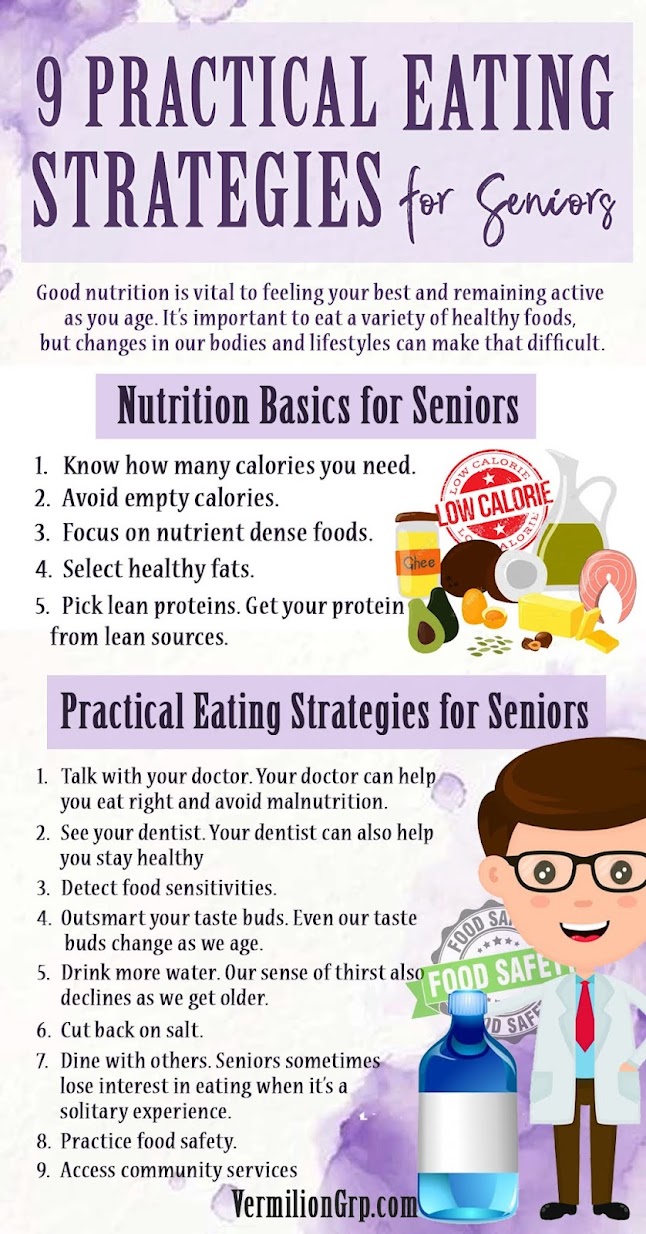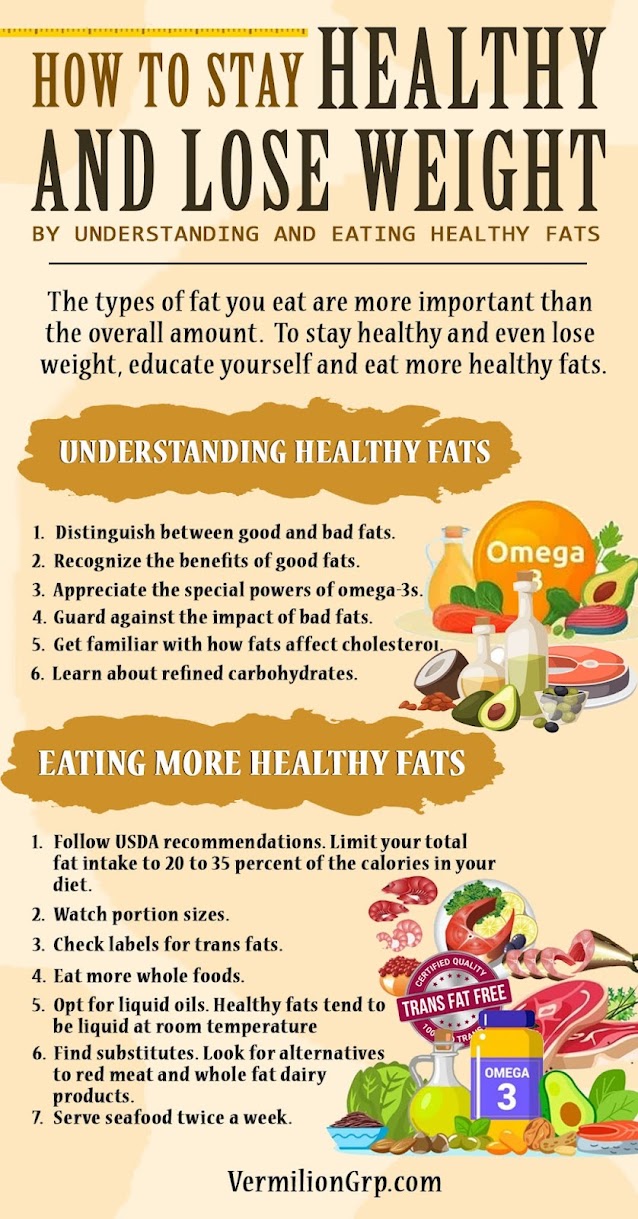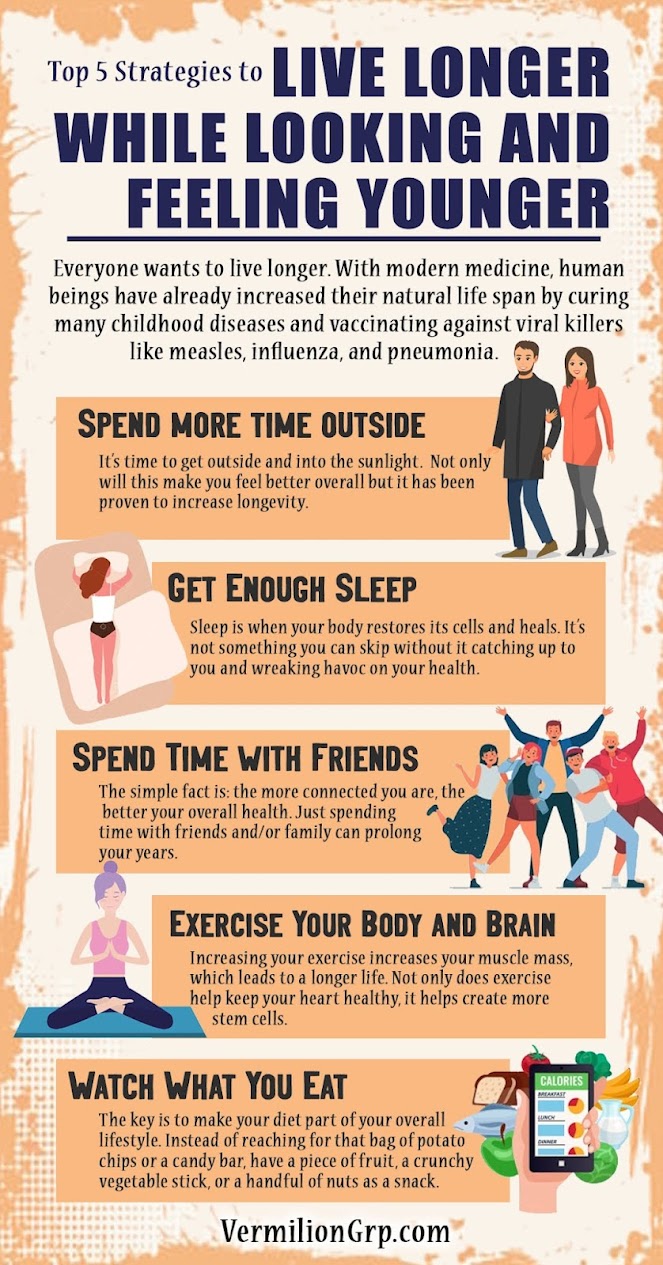Everyone wants to live longer. With modern medicine, human beings have already increased their natural life span by curing many childhood diseases and vaccinating against viral killers like measles, influenza, and pneumonia.
Top 5 Strategies to Live Longer While Looking and Feeling Younger
You’re not likely to die from infections, either, thanks to antibiotics, nor are you to succumb to diseases like diabetes, because of the development of insulin.
And when reflecting on how much the average lifespan has changed over the years, there’s a lot to be thankful for.
(1) Spend more time outside
It’s time to get outside and into the sunlight. Not only will this make you feel better overall but it has been proven to increase longevity.
Here’s why:
When you expose your skin to sunlight, it produces vitamin D.
Doctors estimate that as many as 50% of modern humans don’t get enough sunlight to produce the proper levels of vitamin D.
This is an easy fix for any of us. Just go outside for 15 minutes a day and expose your face and hands (at least) to sunlight.
Remember not to overdo it, because the ultraviolet light will also cause burns and skin cancer if you stay out too long. Fifteen minutes is plenty of time to get that vitamin D into your skin.
Vitamin D isn’t just important for healthy bones, but it’s also helpful with heart disease, diabetes, depression, and other conditions.
It’s becoming more and more apparent that this “vitamin” is an essential part of your health. So, open the door and step outside!
(2) Get Enough Sleep
Chances are, you’ve heard this one before.
Today, the average person is almost always chronically sleep-deprived. We just can’t seem to put down what we’re working on and relax.
A recent study shows that a regular sleeping habit—going to bed and getting up at around the same time daily—is essential for health and longevity.
Sleep is when your body restores its cells and heals. It’s not something you can skip without it catching up to you and wreaking havoc on your health.
Kids and teens need around ten solid hours of sleep to function at their best. Adults need at least six, with seven to eight being ideal.
Too little sleep is linked with a 12% greater risk of early death. It may also cause chronic inflammation because your cells cannot repair themselves, and has been linked with heart disease, diabetes, and obesity.
And, all of these conditions are linked with a shorter lifespan.
On the other hand, you don’t want to stay in bed too long, either. It’s all about striking a balance.
That’s because excessive sleep (over 8 or 9 hours a night) could also lower your lifespan by around 38%.
It’s also associated with depression and low physical activity, both of which can reduce your lifespan in the same way that too little sleep does.
(3) Spend Time with Friends
The simple fact is: the more connected you are, the better your overall health.
Just spending time with friends and/or family can prolong your years.
Scientists aren’t sure exactly why positive relationships with a spouse, family, and/or friends can extend your life, but perhaps it’s because having such relationships reduces your levels of stress.
It could also be that people in close relationships are more likely to take care of themselves and less likely to take dangerous risks, thus shortening their lives.
Scientists report that keeping a healthy social circle can help you live up to 50% longer.
In fact, having just three positive social ties could lower your risk of an early death by up to 200%.
Studies also find that healthy social networks are linked to positive changes in your heart, brain, hormones, and immune system—all of which can reduce your risk of chronic diseases.
Make the effort to spend more time with friends and family. Even a telephone call will keep you in touch, or a Zoom meeting with an extended family or circle of friends.
Take the time to improve your communications, thus strengthening your bonds.
One good way of communicating is by telling stories. Go do things with your friends and family so you have good stories to talk about. Share the latest funny story from your family to your friends, or vice versa. Stories help keep your relationships alive.
If you don’t have friends or family living close, make new ones. Volunteer or join a social club. Take classes or join your neighbors at the local senior center. Get out there and make an effort!
And finally, many studies have shown a link between improved health and increased longevity and providing support to others as well.
(4) Exercise Your Body and Brain
Exercise. Is there a less detested word in most people’s vocabulary?
However, it is a proven fact that a sedentary lifestyle lowers your lifespan.
Muscle mass is one of the best predictors of longevity. Unfortunately, we all lose this muscle mass as we age (it’s called sarcopenia, or “flesh poverty”).
The good news is that you can increase your muscle mass instead of losing it.
Guess how?
Increasing your exercise increases your muscle mass, which leads to a longer life. Not only does exercise help keep your heart healthy, it helps create more stem cells.
These are undifferentiated cells in your body that can transform into other types of cells when needed, such as heart, lung, liver, skin, etc.
Increased stamina and muscle mass also reduces the risk of falling, which is a big factor as you age.
One study published in the British Journal of Nutrition found that elderly men, put on a three-month resistance training program (three sessions per week), had better motor control, increased muscle strength, and lower fat mass than those who didn’t exercise.
Makes sense, doesn’t it? “Use it or lose it.”
Another study showed that people who exercised vigorously for three hours a week had cells and DNA that were nine years younger than their counterparts who didn’t exercise.
That’s a little over thirty minutes of exercise a day, which doesn’t sound like too much when you think of it that way. It’s better to exercise daily rather than try to do three one-hour sessions a week.
If you exercise Monday, Wednesday, and Friday, for example, and something happens to make you miss Friday’s session, that’s four whole days without any exercise at all—a sure way to disaster for your exercise habit.
Daily exercise also helps improve your energy levels and your sleep patterns. It’s more important, for your life expectancy, to keep the habit up year after year instead of going through periods of intense exercise followed by little or nothing.
You don’t have to go to the gym every day, either. A simple brisk walk will do the trick, or home exercises like free weights, yoga or tai chi, or deep stretching, will work so long as you’re doing some brisk movements for about thirty minutes a day.
In addition to your body, your brain needs a little exercise, too.
Challenge your brain every day by trying something new, even if it’s just driving home from work a different way. Take a class and learn something new. Work puzzles or learn to crochet or knit.
Travel, seek out new experiences, and become an eternal student. Your brain thrives on challenges and a working brain is a young brain.
(5) Watch What You Eat
This is another important component to extending longevity and you’ve probably already heard from your doctor.
Today, “junk” food is so common that our health is imperiled by it. Life expectancy has been linked to 3 dietary factors: fewer bad fats, more antioxidants, and lower weight.
You don’t have to become a vegan to lower the amount of bad fats in your diet, nor to get more antioxidants.
You already know which foods are good for you: fruits and veggies, lean meats, fewer carbs and saturated fats, less sugar and more water.
The key is to make your diet part of your overall lifestyle. Instead of reaching for that bag of potato chips or a candy bar, have a piece of fruit, a crunchy vegetable stick, or a handful of nuts as a snack.
In addition, you’ll want to limit your portion sizes. We get used to “restaurant sizes,” which are vastly oversized in nearly every case.
A piece of meat should be about the size of the palm of your hand (not including fingers and thumb). Starchy foods should be the smallest portion on your plate, not the largest.
And skip the sweetened drinks in favor of unsweetened tea or water.
One good method of measuring the proper portion sizes is called the “plate method.”
Take a small plate (not the largest one in your set) and divide it into half. Fill one half of the plate with your healthy vegetables and/or fruits.
Now divide the other half into half again. One of those sections will hold your meat and the other will hold a starchy food like bread, potatoes, or pasta.
Another good rule to follow is the “natural food” rule: the closer your food is to being raw, the healthier it is for you.
Raw fruits and veggies are healthier than cooked ones, and leaving the skins on helps even more. Whole grain is better for you than white bread or rice. Lean meats are better than processed ones like bologna or sausages. Added salt is another step away from “raw,” so use salt in moderation.
Some people go so far as to try intermittent fasting.
There are many ways of doing this. Some skip meals and others cut back on the calorie intake for 2 or 3 days out of the week. You can eat the last meal of the day earlier and fast until breakfast the next day (up to a 20 hour fast if you eat early enough).
Whichever method you choose, remember you still need to eat enough nutritious food to sustain your body, so don’t skip every meal or fast for more than a day or two in a row.
























